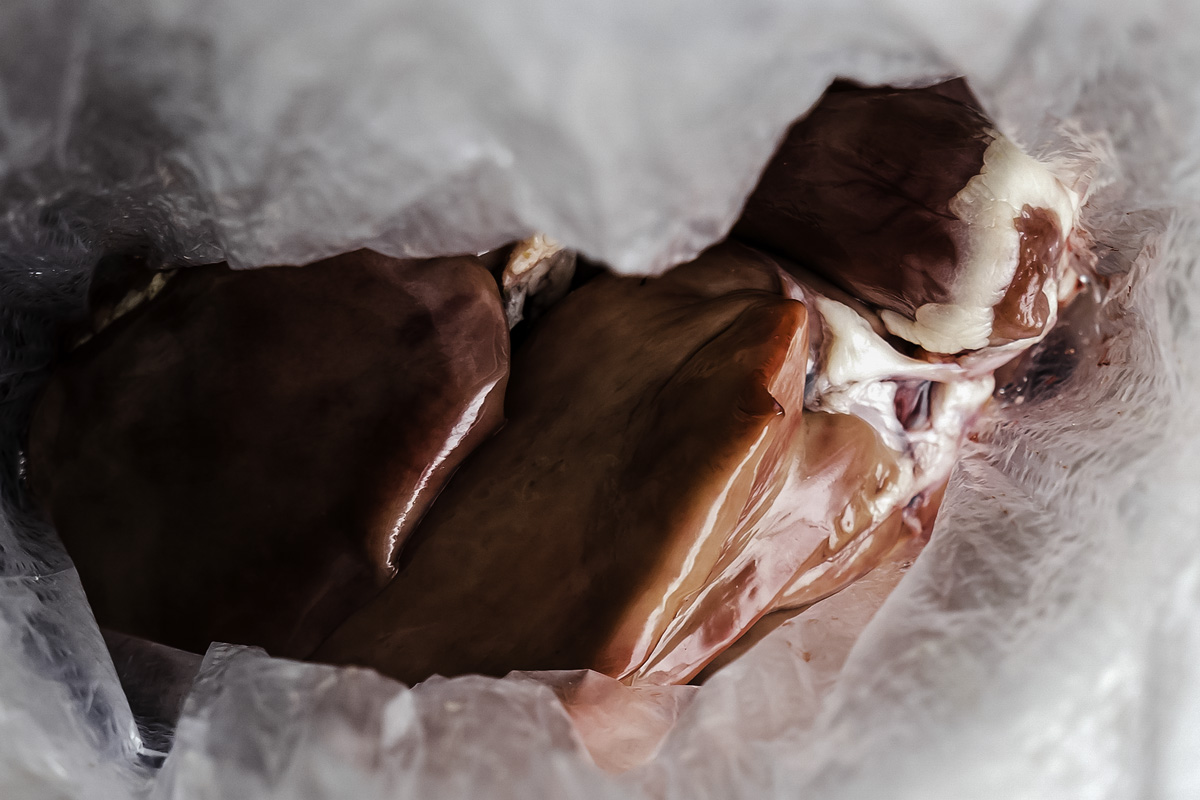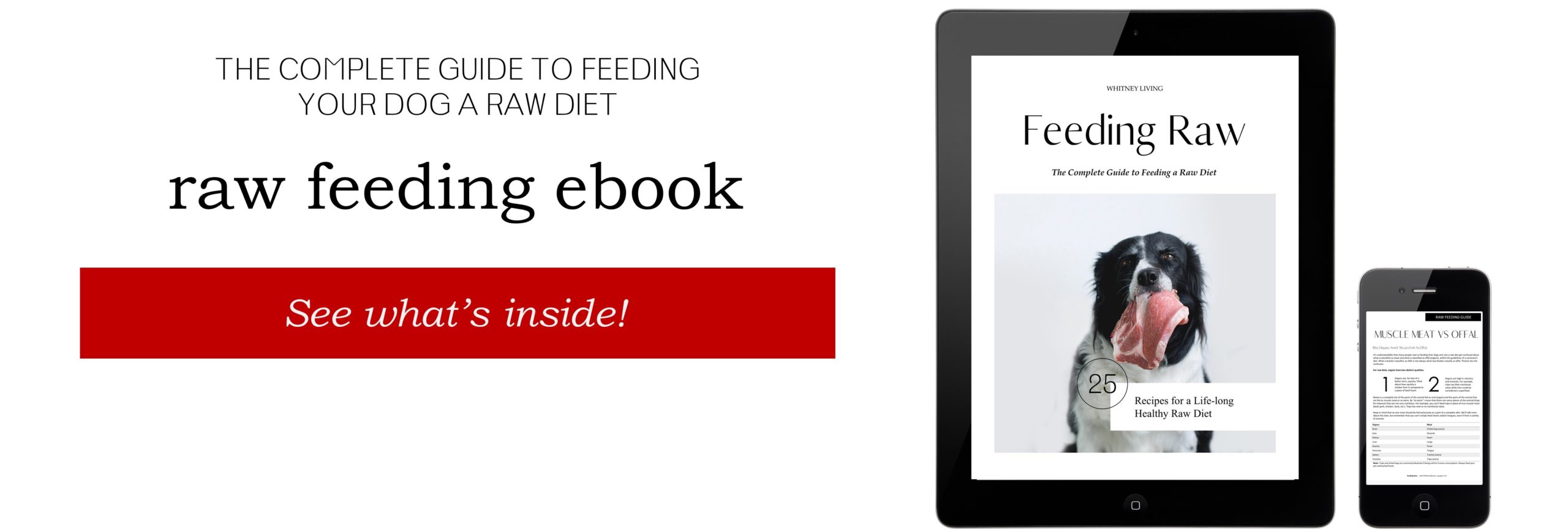I know that, just like me, you want to make sure your raw fed pet is getting everything they need from their diet. Vitamins, minerals, fatty acids, the works.
Below I’m going to share with you the detailed importance of raw liver in your raw fed dog’s diet.
If your dog (or cat) doesn’t like liver, have no fear! I will share feeding tips and tricks at the end of the post.
How Much Raw Liver You Should Feed
If you’ve done your research on feeding a raw diet to your dog then you know that 10% of the diet should be made up of organs and half of that should be liver.
What’s So Important About Feeding Raw Liver to Dogs?
Liver (all secreting organs, really) is considered one of nature’s most powerful superfoods.
Why exactly is liver good for your dog? Liver from everything from beef to duck is very high in many essential nutrients.
Throughout history, people all over the world have highly regarded organ meats, such as liver, for helping with fertility, growth and development, maintaining high energy levels, mental health, and much more. Some cultures consider liver to be so valuable that they won’t touch it with their hands.
The University of California’s Berkeley Wellness website states, “Ounce for ounce, liver is probably more nutritious than any other food.”
I’m going to share with you why liver is one of the most nutrient-dense foods on the planet, packed with vitamin A, iron, B vitamins (especially B12) and phosphorous and magnesium.
7 Benefits of Feeding Raw Liver to Dogs
If you compare the overall nutrient density of liver to other “super foods”, liver outperforms all of them because of how dense its vitamins and minerals are, per oz.
- Raw Liver is Loaded with Vitamin B12
The No. 1 benefit of feeding raw liver to dogs is that it’s very high in vitamin B12. In fact, liver is hands down your dogs’ greatest source of vitamin B12. Vitamin B12 aids in red blood cell formation and improves cellular function. Your dogs also need vitamin B12 for nervous system function, metabolism support and for brain health.
Feeding your raw fed dogs foods that are high in vitamin B12 helps prevent B12 deficiency, which can cause fatigue, muscle weakness, decreased mental function and mood changes.
- Raw Liver is a Great Source of Vitamin A
Liver is one of nature’s most concentrated sources of vitamin A. Vitamin A is a fat-soluble vitamin needed for good vision, overall eye health, skin health, thyroid health, strong bones, gene regulation, facilitating cell differentiation and immune function. It also helps reduce inflammation by fighting free radical damage.
What’s even more important about the vitamin A found in liver is that it’s the active form (also called retinol). Active vitamin A can be used directly by the body and does not need to first be converted like plant-based vitamin A. Of course, your pet carnivore can’t fully utilize plant matter, let alone convert plant-based vitamin A, which makes organ meat essential for a well-rounded raw diet.
- Raw Liver is High in Iron
If your dog struggles with any type of anemia, which is often tied to iron deficiency, then liver is one of the best foods to feed.
Liver contains a powerful combination of folate, iron and vitamin B12. These are three vitamins and minerals your dog needs in order to overcome anemia naturally. This combination can also treat symptoms like low energy, fatigue, or neurological issues.
- Raw Liver is High in Vitamin B6, Biotin and Folate
In addition to vitamin B12, liver is high in vitamin B6, biotin and folate.
These B vitamins help with cellular function. When the process of DNA formation is impaired, this initiates megaloblastic anemia, one of the hallmarks of folate deficiency.
- Raw Liver Includes Copper, Zinc, Chromium and Selenium
Liver also supplies smaller amounts of nutrients, including copper, zinc, chromium and selenium, which have far-reaching benefits for your dog’s metabolism, central nervous system and endocrine systems.
- Raw Liver Supports Liver Function
Are you thinking, “Isn’t your liver toxic; doesn’t liver deal with toxins? Then how is it safe to feed?’’
Actually, toxins are cleaned by the liver, but are not stored in the liver. Liver helps filter waste and toxins from the blood so they can be flushed from the body. Liver is also responsible for metabolizing drugs, hormones and medications, plus the liver helps make proteins that are needed for blood clotting.
In fact, feeding raw liver to dogs is an effective liver cleanse, especially when it’s part of an overall healthy raw diet, because it provides your dogs’ body and liver with all the nutrients their own livers need in order to eliminate waste from their systems.
- Raw Liver Provides CoQ10
Both beef liver and beef heart are rich sources of CoQ10. CoQ10 is associated with cardiovascular health and vascular health, better endurance, reduced inflammation, and much more. Organs are where the greatest supply of CoQ10 can be found.
Your dog’s body’s CoQ10 supplies decrease with age, so feeding raw liver to dogs is essential for keeping levels up.
Which Liver is Best?
Livers from different animals have somewhat different properties, but for the most part liver from various animals provide similar nutritional benefits.
Below are different livers that you can look for in grocery stores, at farmer’s markets, at local butcher’s shops or even online:
Chicken Liver – Chicken liver has the mildest taste so it’s a good starter. Chicken liver has more fat, folate and iron than beef liver.
Beef Liver – Compared to chicken liver, beef liver contains a bit more vitamin B12, vitamin B6, vitamin A, zinc and phosphorus.
Fish Liver – Fish liver (better yet, whole fish) is a great source of omega-3 fatty acids, vitamin A and vitamin D.
You can also feed mutton liver, lamb liver, goat liver, duck liver, turkey liver, goose liver, rabbit liver, etc.
General Raw Liver Nutrition Facts
According to the USDA, one ounce of chicken liver contains the following:
Note: These numbers are for liver from commercially raised chickens. We’ll talk more about this in a minute but the quality of the liver you feed is very important. These numbers are higher in pasture-raised animals.
- 2 grams of fat
- 6 micrograms vitamin B12
- 4,076 IU vitamin A
- 162 micrograms folate
- 6 milligram vitamin B2 (riboflavin)
- 23 milligrams selenium
- 9 milligrams vitamin B5
- 6 milligrams iron
- 9 milligrams vitamin B3/niacin
- 2 milligram vitamin B6
- 125 milligrams phosphorus
Why Buying Quality Liver Matters
The key to your dog getting all of these benefits from raw liver is feeding the right kind: liver from healthy, grass-fed or pasture-raised animals, fed organic diets. I recommend that you try your best to avoid feeding the organs of animals who were not pastured and weren’t fed their own species appropriate diet.
Feeding Raw Liver to Dogs Who are Picky Eaters
If your dog turns his nose up at liver you need to practice tough love, first and foremost. Don’t give your dog options. Make it clear that they must eat the food you give them. Save and give back what they didn’t eat (add nothing else) at their next meal.
Liver is not the tastiest food so it can help to freeze it before feeding it to your dog. Frozen raw liver doesn’t taste as strong.
Add raw liver to your raw fed dog’s diet slowly so as not to cause digestive upset.

